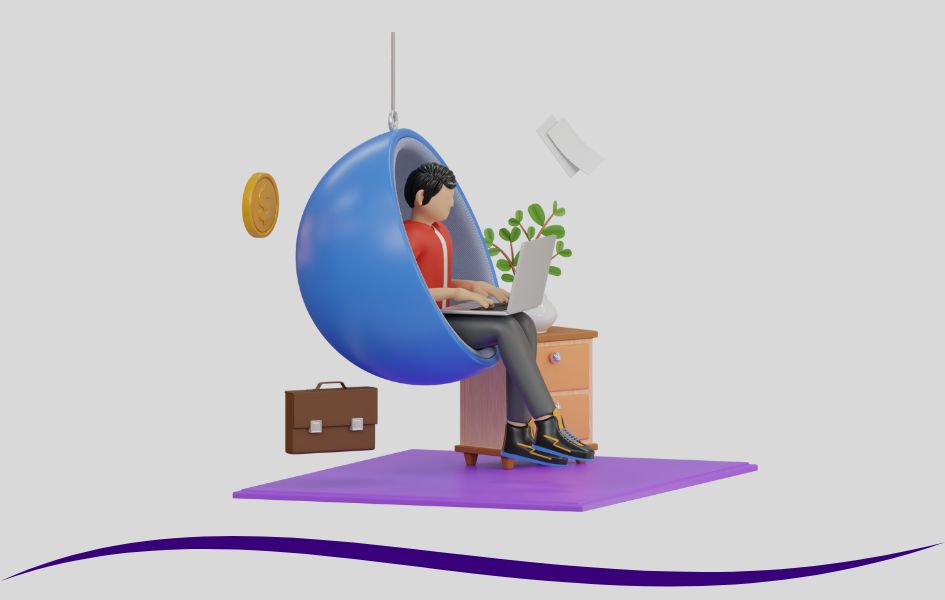Working from home offers a unique blend of flexibility and freedom, but it also comes with its own set of challenges.
It has become increasingly popular in recent years, offering flexibility, convenience, and the opportunity to create a comfortable and productive work environment.
Whether you are a freelancer, remote employee, or entrepreneur, mastering the art of working from home can significantly enhance your productivity and work-life balance.
In this guide, you will learn tips and tricks, the benefits, and challenges of how to work from home.
🔑 Key Highlight
- Create a specific area in your home as your workspace to mentally separate work from personal life, reducing distractions and boosting productivity.
- Use time management techniques like the Pomodoro Technique to maintain focus and set clear boundaries between work and personal time to avoid burnout.
- Schedule short breaks every couple of hours to rest your eyes and refresh your mind, preventing mental fatigue and improving overall productivity.
- Communicate with housemates or family members about your work schedule to avoid unexpected interruptions and create a harmonious living environment.
- Develop a consistent work routine with designated start and end times, including regular breaks, to maintain a healthy work-life balance and improve overall well-being.
Steps of how to work from home?
Work from home is a work arrangement where employees perform their jobs from a location outside of the office setting, typically from their home. It is also called remote work sometimes. This enables flexibility and eliminates the need for a daily commute.
Work from home has become increasingly popular in recent times due to advancements in technology and the rise of the knowledge economy. Many jobs can be effectively performed remotely as long as they don’t require physical presence on-site.
Here are some points that help you work from home successfully:
1. Create a Dedicated Space
A dedicated workspace helps you to separate your work zone from the relaxation areas of your home. This physical separation helps you mentally switch gears when you enter your workspace, minimizing distractions from household chores, TV noise, or family members going about their day.
With fewer distractions, you can concentrate better on your tasks and improve your overall productivity. This can create a positive and inspiring environment that keeps you motivated and engaged throughout the workday.
2. Have the Proper Technology
To have proper technology at home is like building a high-tech bridge between you and your remote workplace. The right technology allows you to share files with your team while working from home. It helps you grab your laptop and work during a break or move to a quieter corner for a focused task.
The right CRM software helps you manage client interactions seamlessly, and project management tools keep your team organized and accessible from your home office. This translates to a smoother work experience, reduced frustration, and ultimately, greater satisfaction with working from home. You can aslo use VoIP technology to work from home.
3. Manage your time and set boundaries
Time management and boundaries create a healthy work environment. By managing your time effectively, you can avoid feeling overwhelmed and stressed, and allow you to set clear boundaries between work and personal life.
Use time management techniques like the Pomodoro Technique (focused work intervals with short breaks) to help you slice this pie efficiently. You can dedicate bigger portions to important tasks and schedule breaks to avoid burnout. This keeps you focused, prevents procrastination, and ensures you finish more quickly.
4. Take Break
Take 10-minute break every two hours to relax you eyes and refresh yourself. Short breaks prevent metal fatigue and allow you to come back to task with renowned focus.
A break can be your stress-buster. Stepping away from work for a bit allows you to de-stress, clear your head, and come back feeling refreshed and more positive.
5. Stay Connected with Your Team
Staying connected with your team is crucial for a positive and productive work-from-home experience. It allows you to learn from your colleagues’ expertise and share your knowledge. The more you connect with colleagues, the stronger your relationships become.
Effective communication between your team allows you to celebrate successes together, offer support during challenges, and maintain a positive team spirit, even when physically apart.
6. Limit Distractions
Avoding distraction is your secrete weapon for work from home sucess. Distractions like phone dings, social media alerts, or even background noise can divert your brain form work. Constant distractions can be mentally draining and lead to stress. You can use the best headset to avoid noise while working from home.
By limiting them, you create a calmer work environment that allows you to focus on your work without feeling disturbed. Finally, this translates to a better work-life balance. No more blurring the lines.
7. Coordinate with Others in the Home
Open communication makes better coordination with your housemates so that they cannot disturb you during your work time. This allows you to focus on your tasks without unexpected interruptions, leading to better quality work and a more productive workday. Discuss work schedules, quiet times, and expectations for everyone living there.
Now image your home is functionating like a well-oiled machine, where everyone understands each other’s routines and needs. This creates a more harmonious living environment for everyone.
What are the tips and trick of work from home?
Working from home can be highly rewarding if approached with the right strategies.Here are some tips and tricks to help you thrive while working from home:
Build remote communication best practices
1. set communication guidelines
Give team members clear instructions on when and how to communicate. Use tools like Slack for instant messaging, email for formal communication, and video conferencing for meetings.
2. set project goals and expectations early
Establish project goals, deliverables, and deadlines early on to make sure everyone is on the same page.
3. Overcommunicate when working in different time zones
Ensure all relevant information is shared and documented, considering delays in response due to time zone differences.
4. Record team meetings
Record online meetings so that participants can review the conversation later and team members who were unable to participate can catch up.
Create ways to stay productive at home
5. Find your productivity window
Decide which hours of the day you are most productive, then plan your most crucial work for these times.
6. Combine your to-do list with time blocking
Allocate specific blocks of time for each task on your to-do list to ensure focused work periods.
7. Limit distractions
Establish limits with family members or roommates, utilize noise-canceling headphones, and make a quiet workstation to reduce disruptions.
8. Commit to a heads-down time
To increase in-depth work and attention, set aside specific periods of the day to work without distractions or meetings.
9. Tackle high-priority tasks in the morning
Start your day with the most critical tasks to take advantage of high energy levels and focus.
Optimize your space and your life
10. Create a morning routine
Just like in an office, to have a morning routine helps you transitions into works mode and sets the tone for the day.
11. Stick to a schedule
Establish a work schedule and do your best to follow it. This involves deciding on start and finish times, as well as breaks.
12. Define a separate physical workspace
Decide a dedicate a specific area in your home as your workspace. This helps separate your work life from your personal life and reduces distractions.
13. Create your ideal office
Make your workstation cozy and practical. Purchase some nice lighting, the best laptop, and an ergonomic chair. Clear the space to reduce distractions and encourage concentration.
14. Declutter your workspace
A tidy workspace can improve your mental clarity and help you focus better.
15. Communicate expectations to your housemates
If you live with others, discuss your work hours and explain when you need quiet time.
16. Align your skills with a WFH role
While not exactly a tip for your current workspace, this encourages you to consider if your skills are well-suited for a remote position.
Support your remote team
17. Recognize your team’s successes
To keep team members feeling valued and inspired, it’s critical to acknowledge and appreciate their work. Find methods to express your gratitude and support, whether by email, a public shout-out on chat, or in person at a meeting.
18. Provide opportunities for team engagement
Build a sense of community to guard against feelings of loneliness. Plan online get-togethers, online team-building exercises, or even just a chat room for casual conversations. This maintains your team feeling cohesive and fosters relationship-building.
19. Configure your remote collaboration tools
Utilize a range of resources to create efficient channels of communication. Some examples may include project task-tracking software, video conferencing systems for meetings, and instant messaging applications for brief inquiries or updates.
20. Implement a team collaboration tool
Consider using a shared workspace or document management platform. This allows everyone to work on projects together seamlessly, share information easily, and stay on the same page.
21. Schedule regular check-ins
Set up one-on-one meetings with your team members since you can’t just strike up a conversation by the water cooler. These routine check-ins provide you with the chance to discuss their specific requirements, provide professional development advice, and monitor their well-being.
What are the benefits of working from home?
Working from home offers a variety of benefits, both for employees and employers. Here are some of the top advantages:

Better work-life balance
A lot of work-from-home jobs provide flexible schedules, so you may arrange your days any way you choose as long as you deliver high-quality work on time. Because of this independence, you can do things that make you happy and fulfilled. You can enhance your work-life balance through your leisure time rather than being worn out from work. You can take charge of your time and well-being by making a plan that fits your priorities and lessens stress instead of letting work rule your life.
Reduce commute stress
Working from home means no more traffic jams, packed trains, or unreliable schedules. This saves time and frustration so that you can start your day relaxed and focused. You avoid the stress hormones that come with a difficult commute, leading to better physical and mental health. With that extra time, you can sleep in, exercise, or simply breathe, boosting your overall well-being and work performance.
Flexible schedule
Remote work typically allows you to establish a personalized routine that suits your needs. You have the flexibility to take breaks as necessary, refresh yourself, and boost productivity upon your return. Implementing the Pomodoro technique can help you effectively schedule and enjoy these breaks.
Improved focus
Your productivity will increase because you can create an atmosphere that suits you and helps you concentrate. You’ll be able to get greater results in less time if you don’t have the interruptions of a regular and workplace schedule. Additionally, it gets rid of some of the things that make the workplace uncomfortable or unfavorable. This is due to the fact that remote workers often engage in less office politics and gossip.
Wear comfortable clothes
One obvious advantage of working from home is being able to wear comfortable clothing, which most remote workers value. Whether you work in sportswear or all-day jammies to stay motivated, your outfit is probably much more comfortable than the business casual often expected in an office.
What are the challenges of working from home?
Working from home (WFH) offers many benefits, but it also comes with its own set of challenges.

Some of the main challenges include:
- Maintaining focus and avoiding distractions: Home environments can be full of distractions, from family members to chores to the allure of the fridge. It takes discipline to stay on task and avoid getting pulled away from work.
- Feeling isolated and missing social interaction: The lack of face-to-face interaction with colleagues can lead to feelings of isolation and loneliness. Remote workers may miss out on casual chats, team lunches, and the sense of camaraderie that comes with working in an office.
- Blurring the lines between work and personal life: Without a clear separation between work and home, it can be easy to end up working long hours or checking work emails constantly. This can lead to burnout and difficulty switching off.
- Communication challenges: Remote work can make communication with colleagues and managers more difficult. Misunderstandings can arise more easily without nonverbal cues and in-person interactions.
- Technical Problems: Reliable internet access and having the necessary technology can be an issue. Additionally, dealing with technical problems without on-site IT support can be challenging.
Final Words
Whether you’re optimizing your workspace or creating a routine, maintaining good nutrition can often be the overlooked aspect of working from home. With services like a 5-star meal kits delivery service, you can ensure that you have nutritious and delicious meals ready to go, leaving you with one less thing to worry about in your busy schedule.
Working from home effectively requires a balance between your work and personal life. Create a dedicated workspace, establish a routine, and prioritize clear communication with colleagues. But also remember to schedule breaks, maintain a healthy lifestyle, and set boundaries between your work and personal life.
Create a routine for yourself, even though you have more flexibility. Set regular work hours, just like you would in an office. Schedule breaks for lunch and short walks throughout the day to stay focused and avoid feeling burnt out. By following these tips, you can create a home office that’s both productive and good for your well-being.
Explore KrispCall’s cloud-based phone system to call and text from anywhere on any device, including computers, laptops, or even smartphones, without the need for additional devices.
FAQ
What is work from home?
Work from home (WFH) is a the practice of employees performing their job duties from their own residence rather than commuting to a traditional office setting. This arrangement has become increasingly popular due to advancements in technology, which allow for effective communication and collaboration from remote locations. During COVID, working from home was very popular among employees.
What types of jobs can be done remotely?
Many types of jobs can be done remotely, particularly those that primarily involve computer-based tasks and digital communication. Here are some common examples:
- Software Developer
- Content Writer
- Digital Marketing Specialist
- Graphic Designer
- Virtual Assistant
What equipment and technology do I need to work from home?
The equipment and technology you’ll need to work from home depend on the specifics of your job. Here are some common examples:
- Computer
- Reliable internet
- A phone
- Headphones
- Printer
- Comfortable chair





